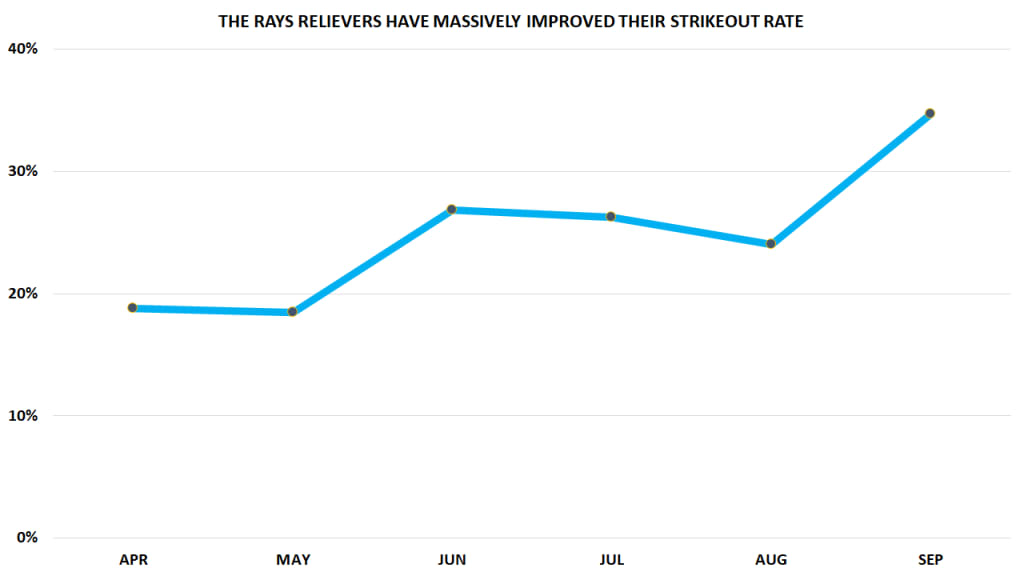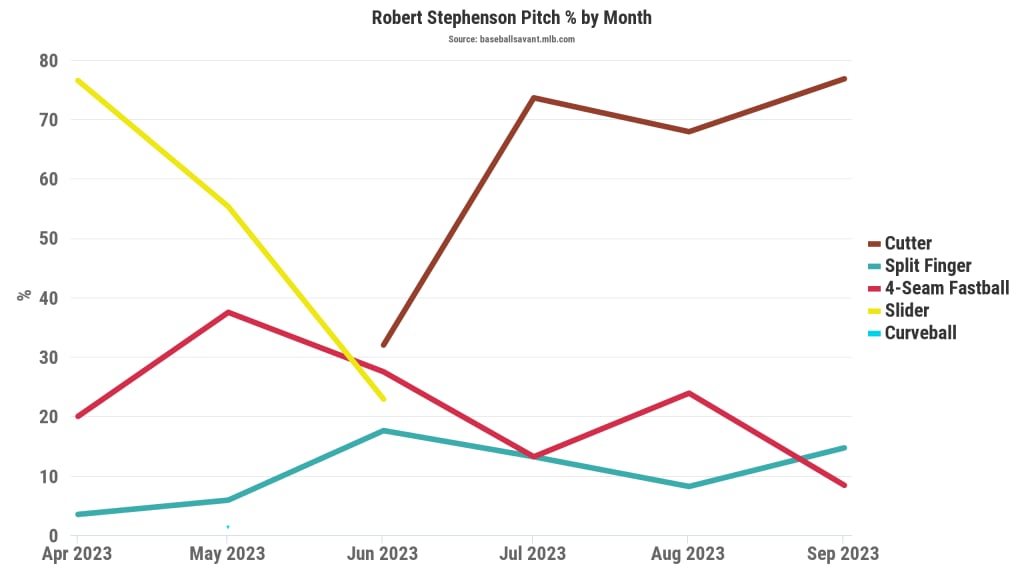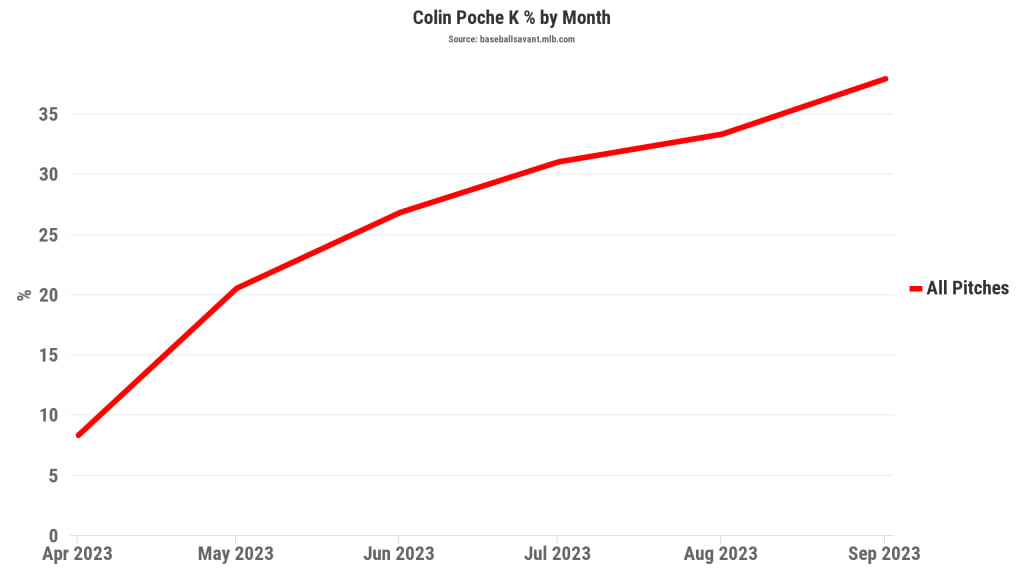As the Rays were getting off to a blisteringly hot start – 13-0 at first, and then 23-6 through April and 40-18 through May – something odd was happening, a concerning undercurrent that was easily obscured by the team’s otherwise sparkling performance. Though it wasn’t allowing many runs, Tampa Bay’s bullpen simply wasn’t missing any bats.
We mean it: Really not missing any bats. In April, Rays relievers struck out only 19% of batters, worse than any team save Oakland. In May, they struck out just over 18% of batters, worse than every single other team. Put the two months together, and a team that was otherwise dominating in other areas of the game had a bullpen that dead last in strikeout rate, behind an A’s unit that had a 6.23 ERA.
Seems bad, right? It was, bad enough that in June, FanGraphs ran an article titled “The Rays Bullpen Has Been Surprisingly Poor.” So guess which bullpen has baseball’s highest strikeout rate since June? It’s the Rays, who have struck out just north of 27% of hitters they’ve seen over the last four months. Going from worst to first within the span of a single season would be pretty cool, if that’s all it was.
It’s not.

Tampa Bay’s bullpen hasn’t just improved; the September Rays are on track to have the second-highest bullpen strikeout rate of any team in any month in any season dating back to the start of divisional play in 1969, which is just about as far back in baseball history as any bullpen stat should be taken seriously. Four months ago, they were missing bats less than any other group in the game. Right now, they’re doing it better than anyone, essentially, ever.
Highest bullpen strikeout rate months since 1969
- 35.9% // Rays, Sept. 2023 (through Wednesday)
- 35.5% // Astros, June 2018
- 34.2% // Brewers, Sept. 2018
- 34% // Yankees, June 2018
- 33.9% // Yankees, Sept. 2017
- 33.9% // Astros, Sept. 2022
As the team heads into the playoffs, that's more than a little impressive -- especially because it's been done without Jason Adam, who had a 40% strikeout rate in August but has been on the injured list for all of September.
How do you manage to go from “worst for two months” to “maybe the best month ever?” There are different faces in the ‘pen right now, for sure; obviously a unit that wasn’t missing bats in April is not going to make it to September without any personnel changes. The April/May Rays had 12 pitchers face at least 25 batters in relief, and exactly one of them, Colin Poche, has remained on the active roster all season long, so yes, there’s been some turnover.
But it’s more than that, too. Here’s how they did it. (All stats are through Wednesday.)
Some of those early pitchers aren’t part of the core any longer.
Obviously. Of the other 11 early-season regulars aside from Poche, three haven’t been seen in months.
- Yonny Chirinos (claimed by Atlanta off waivers)
- Ryan Thompson (released in August, now with Arizona)
- Garrett Cleavinger (season-ending knee injury in May)
Five more are still with the organization, but have spent most of the season bouncing between Tampa Bay, Triple-A Durham and/or the injured list.
- Jalen Beeks (second-half MLB innings: 5)
- Cooper Criswell (9 IP)
- Calvin Faucher (6.2 IP)
- Josh Fleming (3 IP)
- Trevor Kelley (2 IP)
Only Beeks is on the current active roster, and his appearance on Wednesday night was his first in three weeks. (He struck out five of the nine Rays he faced.) So if you’re thinking “near-total bullpen turnover,” that’s a big part of it. But it’s not just that, is it? With apologies to Kevin Kelly, Erasmo Ramirez, Andrew Kittredge, Chris Devenski and a few other semi-regular members of the bullpen, we’re going to narrow this down to The Big Five – three of whom weren't on the Opening Day roster – and what changed from the early part of the season to right now.
Ordered for no other reason than the narrative path we choose to take, these are the pitchers that have taken the Rays from worst to first:
1. Robert Stephenson
What changed: Being traded from Pittsburgh to Tampa Bay in June
It’s not entirely true that teams should never trade with the Rays, because if they never let go of good players, then Blake Snell, Germán Márquez, Tommy Pham and Jake Cronenworth might still be in blue and lighter blue. Still, identifying something of value in an underperforming pitcher on a lesser team is an Extremely Rays Thing to do, and they’ve absolutely nailed it again twice this year.
The biggest win is in Stephenson, a 2016 first-round pick of the Reds who had generally never lived up to his prospect hype and carried a 5.33 ERA as a little-noticed Pirates middle reliever.
- With PIT: 28% K rate
- With TB: 42% K rate
That almost understates it, because Stephenson has also increased his strikeout rate each month with the Rays; he’s at 52% in September. Since the trade, he’s got the fourth-highest reliever strikeout rate in baseball, behind only Aroldis Chapman, Félix Bautista and one of his own teammates, whom we’ll get to in a second. His change is easy to see – whether you think he dropped his slider for a cutter or just tightened up the cutter he had, the Rays had him work differently.

Upon his arrival, Rays pitching coach Kyle Snyder “mentioned a couple tips related to the positioning of his hand on the ball and the mentality behind it,” as MLB.com’s Adam Berry wrote last month, a fix that Stephenson was able to implement the same day – in case you’re wondering how the best teams are operating these days.
2. Jake Diekman
What changed: Being released by the White Sox in May
Like Stephenson, Diekman was toiling unsuccessfully for a non-playoff team, but at least Stephenson required a trade. Instead, Diekman had been simply cut loose by the White Sox in early May, a decision that wasn’t entirely without merit, as the veteran lefty had posted a 7.94 ERA with more than a walk per inning for Chicago. The Rays signed him to replace the injured Cleavinger and …
- With CWS: 19% K rate
- With TB: 29% K rate
… the strikeouts exploded. What changed? Former teammate Joe Kelly made it easy on us, explaining that the Rays said “'stop throwing your sinker and cutter, throw your four-seamer and breaker only, throw two pitches instead of four.’ Now he’s throwing more strikes. I talked to him, and that’s all he’s done, throwing four-seamers down the middle and breaking balls instead of sinkers and cutters. They simplified it.”
It’s not quite that simple – while it’s true the cutter and sinker are mostly gone, the presence of a changeup makes Diekman a three-pitch pitcher – but it’s definitely true that the fastball had been thrown more (60% with Tampa Bay, up from 47% with Chicago). Even that has changed in September, when Diekman has been dominant (13 strikeouts and just one unearned run allowed in 7 1/3 innings) as he’s thrown his sweeper 35% of the time, by far the most of any month. Throw in some release point changes, and, like Stephenson, Diekman is just a different pitcher now.
3. Pete Fairbanks
What changed: Health
You saw the filth he threw at the Orioles to end the biggest series of the season, right? When we said Stephenson had a teammate with a higher second-half strikeout rate, it was clearly because we meant Fairbanks.
Fairbanks did have a 1.13 ERA and 133 strikeouts in 93 1/3 innings last year, so it’s not like success is a new thing, but even he’s seen his production skyrocket from a slow start this year:
- First half: 25% K rate
- Second half: 46% K rate
Why? He missed stretches in May and June this year with arm and hip inflammation, with the latter issue taking him up almost exactly to the All-Star break. So while that 46% K rate in the second half is wildly impressive, it’s not all that different from the 44% rate he showed last year. When healthy, which is the main issue here, this is just who he can be.
Fairbanks, for what it’s worth, is also a previous example of “a pitcher with a high ERA the Rays swiped from someone else,” as he was carrying a 9.35 ERA as a Rangers rookie in 2019 when Tampa Bay traded infielder Nick Solak for him.
4. Colin Poche
What changed: Getting more chase
The lone reliever to last on the active roster uninterrupted all season long, Poche piled up whiffs as a rookie in 2019, then missed the next two seasons recovering from Tommy John surgery. This year, he started slowly, striking out just one of the first 31 batters he faced. And then:

Poche struck out 8% in April. He’s struck out 38% in September. It’s the best strikeout month of his career. But it hasn’t come with any meaningful changes in pitch type, velocity or any of the other usual indicators. What’s clear here is that he’s getting batters to chase more – 25% in April, 40% in May – and when they do chase, to miss a lot more.
5. Shawn Armstrong
What changed: Just being there -- i.e., health.
Armstrong, an occasional opener for the Rays, missed the first two months of the season dealing with a neck issue, and didn’t appear in the bigs until early June. Since his return, he’s allowed four earned runs in 35 games, giving him a 0.74 ERA, which is the lowest of any pitcher (min. 30 innings) in the game. He’s not that good, most likely, but he is good, and he threw exactly zero pitches for the team in the first two months.
Armstrong’s 28% strikeout rate is the best of his career, though it’s not meaningfully out of line with what he’d done in the past – though that’s the point, to some extent, as the Rays added a bat-misser who hadn’t been there earlier in the season. Armstrong, 33, has been around for a long time now; his Major League debut came in a game that also included Joe Mauer and Torii Hunter. But he’s pulling off a neat double trick at the moment:
- His 4% walk rate is a career low; he’s walked just one in his last 13 games
- His 95.2 mph four-seam velocity in September is one of the highest he’s ever had
The Rays may yet get Adam back before the playoffs. Depending on how a postseason rotation shakes out, they may get Zack Littell or another starter in the bullpen as well. It's a good reminder that for bullpens, above all other units, full-season metrics don't tell the story of the roster you'll see in October. Over the course of the season, the Rays relievers are a roughly average strikeout unit. It's clear they're a lot more than that right now.
